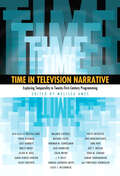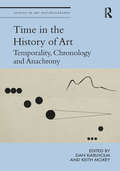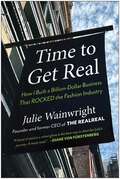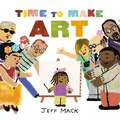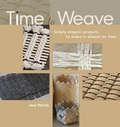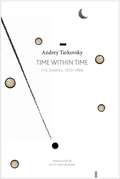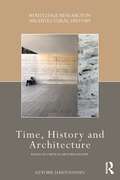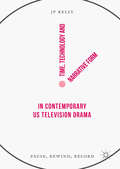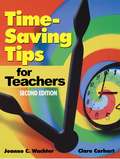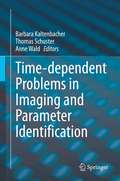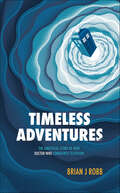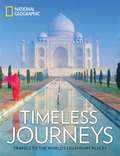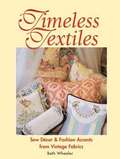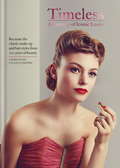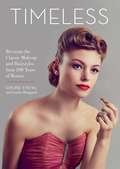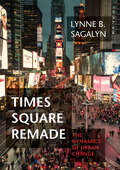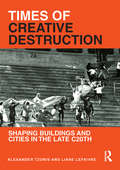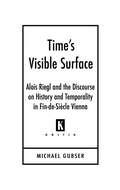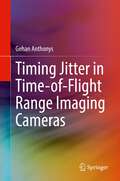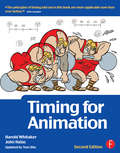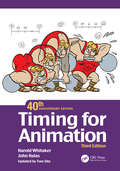- Table View
- List View
Time in Television Narrative: Exploring Temporality in Twenty-First Century Programming
by Melissa AmesThis collection analyzes twenty-first-century American television programs that employ temporal and narrative experimentation. These shows play with time, slowing it down to unfold narrative through time retardation and compression. They disrupt the chronological flow of time itself, using flashbacks and insisting that viewers be able to situate themselves in both the present and the past narrative threads. Although temporal play has existed on the small screen prior to the new millennium, never before has narrative time been so freely adapted in mainstream television. The essayists offer explanations for not only the frequency of time-play in contemporary programming, but also the implications of its sometimes disorienting presence.Drawing upon the fields of cultural studies, television scholarship, and literary studies, as well as overarching theories concerning postmodernity and narratology, Time in Television Narrative offers some critical suggestions. The increasing number of television programs concerned with time may stem from any and all of the following: recent scientific approaches to quantum physics and temporality; new conceptions of history and post history; or trends in late-capitalistic production and consumption, in the new culture of instantaneity, or in the recent trauma culture amplified after the September 11 attacks. In short, these televisual time experiments may very well be an aesthetic response to the climate from which they derive. These essays analyze both ends of this continuum and also attend to another crucial variable: the television viewer watching this new temporal play.
Time in the History of Art: Temporality, Chronology and Anachrony (Studies in Art Historiography)
by Keith Moxey Dan KarlholmAddressed to students of the image—both art historians and students of visual studies—this book investigates the history and nature of time in a variety of different environments and media as well as the temporal potential of objects. Essays will analyze such topics as the disparities of power that privilege certain forms of temporality above others, the nature of temporal duration in different cultures, the time of materials, the creation of pictorial narrative, and the recognition of anachrony as a form of historical interpretation.
Time to Create: Hands-On Explorations in Process Art for Young Children
by Christie BurnettForget stuffy, structured craft activities; your child needs time to create!Rather than merely teaching your child to name colors and to hold a pencil, the hands-on process art experiences in Time to Create encourage discovery through a variety of art media, including drawing, painting, print making, collage, and sculpture.With ideas for encouraging creativity, advice for choosing the right art project, and suggestions for minimizing the mess, you and your child will be on your way to fun-to-do art explorations in no time!Christie Burnett is the writer and founder of the popular Australian parenting blog Childhood 101. She has worked as an early childhood educator for many years and is the mother of two young girls.
Time to Draw Deck: 45 Creative Exercises
by Alyssa Annette BlockThis handy deck of drawing prompts delivers just the bite-sized encouragement that beginners crave and makes it easy to start drawing—anytime, anywhere—and keep drawing. A regular drawing practice improves so much more than technique—it also boosts your self-awareness and productivity. Serving up bite-sized creative prompting in a convenient, display-worthy package, this deck offers 45 inspiring exercises that encourage doodlers, sketchers, and artists of all levels to develop a regular drawing habit.The cards offer a mix of prompts to improve focus, practice skills, or break through blocks and experiment. Keep the deck by your desk and pull a card at random, choose a card every week for a year, or toss the deck in a bag as screen-free entertainment for travel or group gatherings. Whether you're just starting your creative journey or you're ready to shake up an existing drawing practice, these activities will help you integrate the joys and benefits of drawing into your everyday life.CONVENIENT AND EASY TO USE: Keep this deck close at hand for easy anytime creativity. Housed in a sturdy slipcase, these cards are easily stored on your desk or bookshelf yet compact enough to pack in a bag for on-the-go creative prompting. Each card includes a suggested length of time for the activity, so it's easy to choose a card based on the amount of time you have, and most activities are easily accomplished in any setting. On the phone? Long flight? Need a five-minute de-stressing session? There's a card for that! MIX & MATCH FOR MORE VARIETY: The cards are color-coded into three categories: Skills, Focus, and Fun. Choose a card by category or select one card from each category and combine the prompts (for example, mix Skills and Focus) for even more variety! FOR ALL SKILL LEVELS: These exercises are inspired by traditional art school assignments, meditation and art therapy practices, and the professional techniques artists and cartoonists rely on to stay open and curious. Whether you're a seasoned artist looking to expand your horizons or a casual doodler looking for low-pressure drawing activities, this deck makes it easy and fun to build up skills and stretch your creative muscles, at your own pace.EXCELLENT BOREDOM BUSTER: Whether traveling or stuck inside on a rainy day, these playful drawing activities are a perfect way to bust boredom with a little analog creative fun.Perfect for:Art students, aspiring artists, and anyone who wants to engage their creative sidePeople who love adult coloring and other forms of mindful creativityCreative, screen-free group entertainment for gatherings with friends or familyAn entertaining gift for birthday, graduation, holiday, or vacation travelStuffing into a stocking or pairing with a set of pencils, markers, or a how to draw book
Time to Get Real: How I Built a Billion-Dollar Business That Rocked the Fashion Industry
by Julie WainwrightPart tell-all memoir and part entrepreneur crash course, the founder of The RealReal offers an emboldening story of perspective and triumph When she was 52, a recruiter told Julie Wainwright that her failure as CEO of Pets.com made her unemployable. But she proved him—and Silicon Valley—wrong and built her company from an idea into the world&’s largest resource for authenticated luxury resale. Since its launch in 2011, The RealReal has changed the world of fashion forever, making luxury items more accessible and sustainable. Time to Get Real spills the tea on the entrepreneurial journey from a woman&’s perspective and includes all the lessons learned and mistakes made along the way to a billion-dollar business and public company.. This is the book Julie wished she had when she was in the trenches—one that shares the whole exhilarating, stressful, glorious, messy truth about success. Time to Get Real isn&’t just about Julie&’s wild ride through Silicon Valley; it will also show you how to: Build a business from the ground up Hire for startups while avoiding common oversights Overcome workplace bias and adversity Be a shark—and create a unicorn With Julie&’s inspirational story and hard-earned wisdom, this is the perfect read for anyone who has ever imagined starting a company, loves fashion, or wants an uncensored glimpse behind the scenes from a woman who succeeded in spite of it all.
Time to Make Art
by Jeff MackDoes art have to be perfect? Where do you begin? This inspiring picture book about making art doubles as an introduction to the multifaceted and diverse global history of art empowering readers to get creative.Awed by the endless possibilities, a young girl begins asking meaningful questions about creating art. Her questions are answered by a diverse group of artists throughout time and history: from the earliest cave painters to the most recent digital illustrators. Rethinking the familiar Western European timeline of art history, this book introduces readers to diverse works from every era and continent in a playful and inspiring way.Making both art history and art making accessible to all, Time to Make Art nourishes creativity, encouraging young readers to see the artist in themselves.
Time to Scrap: Techniques for Fast, Fun and Fabulous Scrapbook Layouts
by Kathy FesmireScrap it fast, fun, frugal & fabulous! Make scrapbooking your treasured memories quick and easy on your wallet. InTime to Scrap, Memory Makers Master Kathy Fesmire shows you dozens of techniques and shortcuts to save you time and money while still creating fabulous layouts you can be proud of. Ideas include using common household items to stamp, piecing together scraps to form embellishments and adding the look of handstitching to your layout, without the needle and thread. Inside you'll find: Step-by-step demonstrations of innovative scrapbooking techniques that will make your layouts pop 120 eye-catching layouts that are sure to inspire A clock with each layout indicating how long each will take to complete Page sketches you can use for your own fabulous layout design
Time to Weave: Simply Elegant Projects To Make In Almost No Time
by Jane PatrickHighly textured objects such as plaited paper baskets, woven lanterns, small hearth rugs, and cork tables are featured in this beginner's guide to nonloom weaving. The easy instructions teach ancient techniques such as braiding, stringing, and knotting - and call for everyday materials such as copper tape, plastic sheeting, paper yarn, and granite tiles - to produce stunning contemporary designs for the home. A short essay about natural materials and the creative process introduces each project, and lovely photographs showcase the final results: sleek window hangings, stick-and-string coasters, pillows covered in canvas tape, and woven paper cards. A list of resources, an assortment of weaving tips, and suggestions for further reading are included.
Time within Time: The Diaries, 1970–1986
by Andrey Tarkovsky“Tarkovsky for me is the greatest,” wrote Ingmar Bergman. Andrey Tarkovsky only made seven films, but all are celebrated for its striking visual images, quietly patient dramatic structures, and visionary symbolism. Time within Time is both a diary and a notebook, maintained by Tarkovsky from 1970 until his death. Intense and intimate, it offers reflections on Dostoyevsky, Tolstoy, Hermann Hesse, Thomas Mann, and others. He writes movingly of his family, especially his father, Arseniy Tarkovsky, whose poems appear in his films. He records haunting dreams in detail and speaks of the state of society and the future of art, noting significant world events and purely personal dramas along with fascinating accounts of his own filmmaking. Rounding out this volume are Tarkovsky’s plans and notes for his stage version of Hamlet; a detailed proposal for a film adaptation of Dostoyevsky’s The Idiot; and a glimpse of the more public Tarkovsky answering questions put to him by interviewers.
Time, History and Architecture: Essays on Critical Historiography (Routledge Research in Architectural History)
by Gevork HartoonianTime, History and Architecture presents a series of essays on critical historiography, each addressing a different topic, to elucidate the importance of two influential figures Walter Benjamin and Gottfried Semper for architectural history. In a work exploring themes such as time, autonomy and periodization, author Gevork Hartoonian unpacks the formation of architectural history; the problem of autonomy in criticism and the historiographic narrative. Considering the scope of criticism informing the contemporaneity of architecture, the book explores the concept of nonsimultaneity, and introduces retrospective criticism the agent of critical historiography. An engaging thematic dialogue for academics and upper-level graduate students interested in architectural history and theory, this book aims to deconstruct the certainties of historicism and to raise new questions and interpretations from established critical canons.
Time, Technology and Narrative Form in Contemporary US Television Drama: Pause, Rewind, Record
by Jp KellyThis book examines how television has been transformed over the past twenty years by the introduction of new viewing technologies including DVDs, DVRs and streaming services such as Netflix, Hulu and Amazon Prime. It shows that these platforms have profoundly altered the ways we access and watch television, enabling viewers to pause, rewind, record and archive the once irreversible flow of broadcast TV. JP Kelly argues that changes in the technological landscape of television has encouraged the production of narrative forms that both explore and embody new industrial temporalities. Focusing on US television but also considering the role of TV within a global marketplace, the author identifies three distinct narrative temporalities: “acceleration” (24; Prison Break), “complexity” (Lost; FlashForward), and “retrospection” (Mad Men). Through industrial-textual analysis of television shows, this cross-disciplinary study locates these narrative temporalities in their socio-cultural contexts and examines connections between production, distribution, and narrative form in the contemporary television industry.
Time-Saving Tips for Teachers (1-off Ser.)
by Joanne C. Wachter Clare CarhartPerfect for teachers who need help managing their time,Time Saving Tips for Teachers is structured for easy use. Flip through the chapters and apply the ideas that fit immediate needs and style—and includes more than sixty reproducible forms that can be used right away, covering student and parent information, reading and writing coaches, homework, standards for assignments, and supplies, just to name a few. New tips include portfolios, substitute teachers, email, handheld computers, and the Internet!Chapters provide ideas on how to save time without diminishing quality by:Communicating effectively—but brieflyManaging materialsPlanning the week aheadLearning to say "No"Using the Internet to save timeWorking with substitutes and volunteersCreating a filing system that saves timeAvoiding distractionsTreating yourself as a professionalThis guide helps teachers work smarter and enjoy life outside of teaching once again!
Time-dependent Problems in Imaging and Parameter Identification
by Thomas Schuster Barbara Kaltenbacher Anne WaldInverse problems such as imaging or parameter identification deal with the recovery of unknown quantities from indirect observations, connected via a model describing the underlying context. While traditionally inverse problems are formulated and investigated in a static setting, we observe a significant increase of interest in time-dependence in a growing number of important applications over the last few years. Here, time-dependence affects a) the unknown function to be recovered and / or b) the observed data and / or c) the underlying process. Challenging applications in the field of imaging and parameter identification are techniques such as photoacoustic tomography, elastography, dynamic computerized or emission tomography, dynamic magnetic resonance imaging, super-resolution in image sequences and videos, health monitoring of elastic structures, optical flow problems or magnetic particle imaging to name only a few. Such problems demand for innovation concerning their mathematical description and analysis as well as computational approaches for their solution.
Timeless Adventures: The Unofficial Story of How Doctor Who Conquered Television
by Brian J. RobbThis critical history of Doctor Who covers the series 60 years, from the creation of the show to its triumph as Britain's number one TV drama. Opening with an in-depth account of the creation of the series within the BBC of the early 1960s, each decade of the show is tackled through a unique political and pop cultural historical viewpoint, exploring the links between contemporary Britain and the stories Doctor Who told, and how such links kept the show popular with a mass television audience. Timeless Adventures reveals how Doctor Who is at its strongest when it reflects the political and cultural concerns of a mass British audience (the 1960s, 1970s and 21st Century), and at its weakest when catering to a narrow fan-based audience (as in the 1980s). The book also addresses the cancellation of the show in the late 1980s (following the series becoming increasing self-obsessed) and the ways in which a narrowly-focused dedicated fandom contributed to the show's demise and yet was also instrumental in its regeneration for the 21st Century under Russell T. Davies, and analyses the new series to reveal what has made it so popular, reflecting real world issues like consumerism and dieting.
Timeless Journeys: Travels to the World's Legendary Places
by National Geographic Ford CochranFrom Machu Picchu to the Pyramids of Giza and beyond, this travel-lover's delight takes readers on a breathtaking visual journey to the world's most historic wonderlands. Pack your bags for an extraordinary adventure with National Geographic to more than 50 places that have captivated our imaginations for centuries. In this visually stunning volume, the world's leading authority on cultural travel and history showcases bucket-list-ready destinations on every continent, from Easter Island's haunting stone moai to Kyoto's breathtaking temples. Vintage photographs from the National Geographic archives tell the backstory of the discovery and earliest visitors to places like Carthage, Pompeii, Victoria Falls, and more, while showstopping contemporary photographs bring them to life in exquisite detail. Full-spread features highlight lesser-known hidden sites, such as Pompeii's better-preserved sister city Herculaneum and the less-visited Maya city El Mirador in Guatemala’s jungle, offer readers extraordinary opportunities to deepen their travel experience and discover places where the past can truly come to life. With practical travel tips to help readers get started planning their own legendary journey, this is the perfect gift to keep—or share.
Timeless Textiles
by Beth WheelerSew Decor & Fashion Accents from Vintage Fabrics Vintage fabrics take on new meaning as they are used to create delightful pillows, fashions and gifts. Textile expert Beth Wheeler shows you how to transform quilts, handkerchiefs, ties, and drapes into heirloom treasures. Timeless Textiles also offers priceless tips on how to clean, store, manage vintage textile collections. Over 40 fun projects to make, including fashions and home decor items Clear, easy step-by-step directions; patterns included Great tips on how to care for vintage and antique textiles
Timeless: A Century of Iconic Looks
by Louise Young Loulia SheppardBy Louise Young and Loulia Sheppard, 2018 Academy Award nominee for her hair and make-up design on Victoria and Abdul.'If you haven't heard of Louise Young and are interested in period makeup, or any makeup in fact, then we highly recommend you check out her latest book.' - PIXIWOOThe definitive step-by-step guide to recreating the most striking make-up and hair styles of the 20th century.Timeless is a beauty bible for the golden ages of style from renowned film, television and make-up artist Louise Young, along with Academy Award-nominated film industry hairstylist Loulia Sheppard.Step-by-step photography and clear, concise instructions help you to recreate make-up and hair looks from the past 100 years of beauty, from the dark, smouldering eyes of the jazz-age flapper to the red lips and victory rolls of the 1940s, right up to the electric colours of the 1980s and beyond.Accurate, practical and beautiful, this is the ultimate guide to the most classic looks of all time.Between them, Louise and Loulia have provided make-up and hair styling for stars such as Scarlett Johansson, Keira Knightley and Selma Hayek, and on films including Victoria and Abdul, Fantastic Beasts and Where to Find Them, Pride and Prejudice, Florence Foster Jenkins, Anna Karenina and The Duchess, among many others.
Timeless: Recreate the Classic Makeup and Hairstyles from 100 Years of Beauty
by Louise Young Loulia SheppardFrom renowned film, TV, and fashion makeup artist Louise Young-along with leading film industry hairstylist Loulia Sheppard, Timeless is the definitive step-by-step guide to the most iconic looks of a century.Timeless is a beauty bible for the golden ages of style. Step-by-step photography and clear, concise instructions help you to recreate the most memorable makeup and hair looks of the past 100 years, including: The silent-screen "vamp" Jazz-Age bob and smoldering eyes 1930s Hollywood glamour World War II-era red lips and victory rolls The 1950s bombshell Swinging '60s London Look Disco-fever beauty The colorful, eclectic '80s Grunge-era chicThroughout, Timeless provides inspiration and instruction on how to recreate the looks of beauty icons like Louise Brooks, Clara Bow, Ginger Rogers, Myrna Loy, Betty Grable, Rita Hayworth, Ava Gardner, Lauren Bacall, Gene Tierney, Grace Kelly, Lucille Ball, Elizabeth Taylor, Marilyn Monroe, Audrey Hepburn, Jean Shrimpton, Sophia Loren, Farrah Fawcett, Julia Roberts, Brooke Shields, Kate Moss, Drew Barrymore, and many more.Accurate, practical, and beautiful, this is the ultimate guide to the most classic looks of all time-a must-have for makeup artists, hairstylists, classic film fans, and anyone interested in incorporating vintage style into the modern day.
Times Square Remade: The Dynamics of Urban Change
by Lynne B. SagalynThe illuminating evolution of the iconic space of Times Square.What is it about Times Square that has inspired such attention for well over a century? And how is it that, despite its many changes of character, the place has maintained a unique hold on our collective imagination? In this book, which comes twenty years after her widely acclaimed Times Square Roulette, Lynne Sagalyn masterfully tells the story of profound urban change over decades in the symbolic space that is New York City&’s Times Square. Drawing on the history, sociology, and political economy of the place, Times Square Remade examines how the public-private transformation of 42nd Street at Times Square impacted the entertainment district and adjacent neighborhoods, particularly Hell&’s Kitchen.Sagalyn chronicles the earliest halcyon days of 42nd Street and Times Square as the nexus of speculation and competitive theater building as well as its darkest days as vice central, and on to the years of aggressive government intervention to cleanse West 42nd Street of pornography and crime. Thematically, the author analyzes the three main forces that have shaped and reshaped Times Square—theater, real estate, and pornography—and explains the politics and economics of what got built and what has been restored or preserved.Accompanied by nearly 160 images, more than half in color, Times Square Remade is a deftly woven narrative of urban transformation that will appeal as much to the general reader and New York City enthusiast as to urbanists, city planners, architects, urban designers, and policymakers.
Times of Creative Destruction: Shaping Buildings and Cities in the late C20th
by Liane Lefaivre Alexander TzonisTimes of Creative Destruction is about the years that followed the end of WWII, one of the most seminal and dramatic epochs in human history, during which extraordinary star-buildings were born, cities exploded, and an unprecedented world of a ‘Third Ecology’ emerged. Never before was there such a flurry of daring mega-constructions, such daring spatial acrobatics, ‘star’ buildings by star architects attained by star developers, mega-constructions, technological feats, and flourishing spatial acrobatics. But, for all its exhilarating creativity, this was also an era of unanticipated, intractable, irreversible destruction reducing the uniqueness and diversity of cultural, social and ecological peaks and valleys of our world, to a ‘desert flatland’, environmental inequality and unhappiness. This book critically discusses and revaluates these contradictory events, bringing together and commenting on a selection of shorter key texts by Tzonis and Lefaivre, the product of a rare research and writing partnership. The texts, published between the early 1960s and the present, are significant as documents that inform about the period. They are also important and timely because of their critical and influential role in the debates of this era, both creative and destructive.
Times of the Technoculture: From the Information Society to the Virtual Life (Comedia)
by Frank Webster Kevin RobinsTimes of the Technoculture explores the social and cultural impact of new technologies, tracing the origins of the information society from the coming of the machine with the industrial revolution to the development of mass production techniques in the early twentieth century.The authors look at how the military has controlled the development of the information society, and consider the centrality of education in government attempts to create a knowledge society. Engaging in contemporary debates surrounding the internet, Robins and Webster question whether it can really offer us a new world of virtual communities, and suggest more radical alternatives to the corporate agenda of contemporary technologies.
Time’s Visible Surface: Alois Riegl and the Discourse on History and Temporality in Fin-de-Siècle Vienna
by Michael GubserExpands our understanding of Alois Riegl beyond his role as an art historian to a pivotal figure in cultural theory at large, while placing his interest in history and time within the intellectual world of fin-de-siècle Vienna.
Timing Jitter in Time-of-Flight Range Imaging Cameras
by Gehan AnthonysThis book explains how depth measurements from the Time-of-Flight (ToF) range imaging cameras are influenced by the electronic timing-jitter. The author presents jitter extraction and measurement techniques for any type of ToF range imaging cameras. The author mainly focuses on ToF cameras that are based on the amplitude modulated continuous wave (AMCW) lidar techniques that measure the phase difference between the emitted and reflected light signals. The book discusses timing-jitter in the emitted light signal, which is sensible since the light signal of the camera is relatively straightforward to access. The specific types of jitter that present on the light source signal are investigated throughout the book. The book is structured across three main sections: a brief literature review, jitter measurement, and jitter influence in AMCW ToF range imaging.
Timing for Animation
by Tom SitoThe classic work on animation principles, now fully updated for the digital age.
Timing for Animation, 40th Anniversary Edition
by Harold Whitaker John HalasTiming for Animation has been one of the pillars of animation since it was first published in 1981. Now this 40th anniversary edition captures the focus of the original and enhances this new edition with fresh images, techniques, and advice from world-renowned animators. Not only does the text explore timing in traditional animation, but also timing in digital works. Vibrant illustrations and clear directions line the pages to help depict the various methods and procedures to bring your animation to life. Examples include timing for digital production, digital storyboarding in 2D, digital storyboarding in 3D, and the use of After Effects, as well as interactive games, television, animals, and more. Learn how animated scenes should be arranged in relation to each other, how much space should be used, and how long each drawing should be shown for maximum dramatic effect. All you need to breathe life into your animation is at your fingertips with Timing for Animation. Key Features: Fully revised and updated with modern examples and techniques Explores the fundamentals of timing, physics, and animation Perfect for the animation novice and the expert Get straight to the good stuff with simple, no-nonsense instruction on the key techniques like stretch and squash, animated cycles, overlapping, and anticipation. Trying to time weight, mood, and power can make or break an animation—get it right the first time with these tried and tested techniques. Authors Harold Whitaker was a BAFTA-nominated professional animator and educator for 40 years; many of his students number among today’s most outstanding animation artists. John Halas, known as "The father of British animation" and formerly of Halas & Batchelor Animation Studio, produced more than 2,000 animation films, including the legendary Animal Farm (1954) and the award-winning Dilemma (1981). He was also the founder and president of the International Animated Film Association (ASIFA) and former Chairman of the British Federation of Film Societies. Tom Sito is Professor of Animation at the University of Southern California and has written numerous books and articles on animation. Tom’s screen credits include Shrek (2001) and the Disney classics Who Framed Roger Rabbit (1988), The Little Mermaid (1989), Beauty and the Beast (1991), Aladdin (1992), and The Lion King (1994). In 1998, Tom was named by Animation Magazine as one of the 100 Most Important People in Animation.
